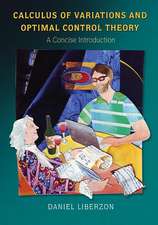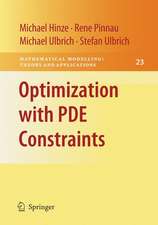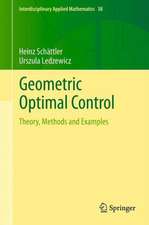An Invitation to 3-D Vision: From Images to Geometric Models: Interdisciplinary Applied Mathematics, cartea 26
Autor Yi Ma, Stefano Soatto, Jana Kosecká, S. Shankar Sastryen Limba Engleză Hardback – 14 noi 2003
| Toate formatele și edițiile | Preț | Express |
|---|---|---|
| Paperback (1) | 374.34 lei 3-5 săpt. | +32.64 lei 7-13 zile |
| Springer – 24 noi 2010 | 374.34 lei 3-5 săpt. | +32.64 lei 7-13 zile |
| Hardback (1) | 664.77 lei 6-8 săpt. | |
| Springer – 14 noi 2003 | 664.77 lei 6-8 săpt. |
Din seria Interdisciplinary Applied Mathematics
- 15%
 Preț: 667.05 lei
Preț: 667.05 lei - 19%
 Preț: 420.87 lei
Preț: 420.87 lei - 15%
 Preț: 980.97 lei
Preț: 980.97 lei - 17%
 Preț: 528.44 lei
Preț: 528.44 lei - 18%
 Preț: 908.71 lei
Preț: 908.71 lei - 18%
 Preț: 1006.38 lei
Preț: 1006.38 lei - 15%
 Preț: 659.67 lei
Preț: 659.67 lei -
 Preț: 498.14 lei
Preț: 498.14 lei -
 Preț: 528.35 lei
Preț: 528.35 lei - 15%
 Preț: 659.02 lei
Preț: 659.02 lei - 15%
 Preț: 480.52 lei
Preț: 480.52 lei -
 Preț: 390.63 lei
Preț: 390.63 lei - 18%
 Preț: 918.61 lei
Preț: 918.61 lei -
 Preț: 388.52 lei
Preț: 388.52 lei - 15%
 Preț: 647.92 lei
Preț: 647.92 lei - 15%
 Preț: 655.60 lei
Preț: 655.60 lei - 23%
 Preț: 734.80 lei
Preț: 734.80 lei - 15%
 Preț: 660.83 lei
Preț: 660.83 lei - 18%
 Preț: 967.08 lei
Preț: 967.08 lei -
 Preț: 809.10 lei
Preț: 809.10 lei -
 Preț: 403.91 lei
Preț: 403.91 lei - 18%
 Preț: 896.84 lei
Preț: 896.84 lei - 18%
 Preț: 1004.00 lei
Preț: 1004.00 lei - 18%
 Preț: 974.19 lei
Preț: 974.19 lei -
 Preț: 399.67 lei
Preț: 399.67 lei - 18%
 Preț: 1181.99 lei
Preț: 1181.99 lei
Preț: 664.77 lei
Preț vechi: 830.96 lei
-20% Nou
Puncte Express: 997
Preț estimativ în valută:
127.20€ • 132.81$ • 105.28£
127.20€ • 132.81$ • 105.28£
Carte tipărită la comandă
Livrare economică 04-18 aprilie
Preluare comenzi: 021 569.72.76
Specificații
ISBN-13: 9780387008936
ISBN-10: 0387008934
Pagini: 528
Ilustrații: XX, 528 p.
Dimensiuni: 155 x 235 x 38 mm
Greutate: 0.95 kg
Ediția:2004
Editura: Springer
Colecția Springer
Seria Interdisciplinary Applied Mathematics
Locul publicării:New York, NY, United States
ISBN-10: 0387008934
Pagini: 528
Ilustrații: XX, 528 p.
Dimensiuni: 155 x 235 x 38 mm
Greutate: 0.95 kg
Ediția:2004
Editura: Springer
Colecția Springer
Seria Interdisciplinary Applied Mathematics
Locul publicării:New York, NY, United States
Public țintă
GraduateCuprins
1 Introduction.- 1.1 Visual perception from 2-D images to 3-D models.- 1.2 A mathematical approach.- 1.3 A historical perspective.- I Introductory Material.- 2 Representation of a Three-Dimensional Moving Scene.- 3 Image Formation.- 4 Image Primitives and Correspondence.- II Geometry of Two Views.- 5 Reconstruction from Two Calibrated Views.- 6 Reconstruction from Two Uncalibrated Views.- 7 Estimation of Multiple Motions from Two Views.- III Geometry of Multiple Views.- 8 Multiple-View Geometry of Points and Lines.- 9 Extension to General Incidence Relations.- 10 Geometry and Reconstruction from Symmetry.- IV Applications.- 11 Step-by-Step Building of a 3-D Model from Images.- 12 Visual Feedback.- V Appendices.- A Basic Facts from Linear Algebra.- A.1 Basic notions associated with a linear space.- A.1.1 Linear independence and change of basis.- A.1.2 Inner product and orthogonality.- A.1.3 Kronecker product and stack of matrices.- A.2 Linear transformations and matrix groups.- A.3 Gram-Schmidt and the QR decomposition.- A.4 Range, null space (kernel), rank and eigenvectors of a matrix.- A.5 Symmetric matrices and skew-symmetric matrices.- A.6 Lyapunov map and Lyapunov equation.- A.7 The singular value decomposition (SVD).- A.7.1 Algebraic derivation.- A.7.2 Geometric interpretation.- A.7.3 Some properties of the SVD.- B Least-Variance Estimation and Filtering.- B.1 Least-variance estimators of random vectors.- B.1.1 Projections onto the range of a random vector.- B.1.2 Solution for the linear (scalar) estimator.- B.1.3 Affine least-variance estimator.- B.1.4 Properties and interpretations of the least-variance estimator.- B.2 The Kalman-Bucy filter.- B.2.1 Linear Gaussian dynamical models.- B.2.2 A little intuition.- B.2.3 Observability.- B.2.4 Derivation of the Kalmanfilter.- B.3 The extended Kalman filter.- C Basic Facts from Nonlinear Optimization.- C.1 Unconstrained optimization: gradient-based methods.- C.1.1 Optimality conditions.- C.1.2 Algorithms.- C.2 Constrained optimization: Lagrange multiplier method..- C.2.1 Optimality conditions.- C.2.2 Algorithms.- References.- Glossary of Notation.
Recenzii
From the reviews:
"Computer vision is invading our daily lives … . Covering all the aspects would be too vast an area to cover in one book, so here, the authors concentrated on the specific goal of recovering the geometry of a 3D object … . The 22 pages of references form a good guide to the literature. The authors found an excellent balance between a thorough mathematical treatment and the applications themselves. … the text will be a pleasure to read for students … ." (Adhemar Bultheel, Bulletin of the Belgian Mathematical Society, Vol. 12 (2), 2005)
"This is primarily a textbook of core principles, taking the reader from the most basic concepts of machine vision … to detailed applications, such as autonomous vehicle navigation. … It is a clearly written book … . Everything that is required is introduced … . an entirely self-contained work. … The book is aimed at graduate or advanced undergraduate students in electrical engineering, computer science, applied mathematics, or indeed anyone interested in machine vision … . is highly recommended." (D.E. Holmgren, The Photogrammetric Record, 2004)
"This very interesting book is a great book teaching how to go from two-dimensional (2D)-images to three-dimensional (3D)-models of the geometry of a scene. … A good part of this book develops the foundations of an appropriate mathematical approach necessary for solving those difficult problems. … Exercises (drill exercises, advanced exercises and programming exercises) are provided at the end of each chapter." (Hans-Dietrich Hecker, Zentralblatt MATH, Vol. 1043 (18), 2004)
"This book gives senior undergraduate and beginning graduate students and researchers in computer vision, applied mathematics, computer graphics, and robotics a self-contained introduction to the geometry of 3D vision. That is the reconstruction of 3D models of objects from a collection of 2D images. … Exercises are provided at the endof each chapter. Software for examples and algorithms are available on the author’s website." (Daniel Leitner, Simulation News Europe, Vol. 16 (1), 2006)
"Computer vision is invading our daily lives … . Covering all the aspects would be too vast an area to cover in one book, so here, the authors concentrated on the specific goal of recovering the geometry of a 3D object … . The 22 pages of references form a good guide to the literature. The authors found an excellent balance between a thorough mathematical treatment and the applications themselves. … the text will be a pleasure to read for students … ." (Adhemar Bultheel, Bulletin of the Belgian Mathematical Society, Vol. 12 (2), 2005)
"This is primarily a textbook of core principles, taking the reader from the most basic concepts of machine vision … to detailed applications, such as autonomous vehicle navigation. … It is a clearly written book … . Everything that is required is introduced … . an entirely self-contained work. … The book is aimed at graduate or advanced undergraduate students in electrical engineering, computer science, applied mathematics, or indeed anyone interested in machine vision … . is highly recommended." (D.E. Holmgren, The Photogrammetric Record, 2004)
"This very interesting book is a great book teaching how to go from two-dimensional (2D)-images to three-dimensional (3D)-models of the geometry of a scene. … A good part of this book develops the foundations of an appropriate mathematical approach necessary for solving those difficult problems. … Exercises (drill exercises, advanced exercises and programming exercises) are provided at the end of each chapter." (Hans-Dietrich Hecker, Zentralblatt MATH, Vol. 1043 (18), 2004)
"This book gives senior undergraduate and beginning graduate students and researchers in computer vision, applied mathematics, computer graphics, and robotics a self-contained introduction to the geometry of 3D vision. That is the reconstruction of 3D models of objects from a collection of 2D images. … Exercises are provided at the endof each chapter. Software for examples and algorithms are available on the author’s website." (Daniel Leitner, Simulation News Europe, Vol. 16 (1), 2006)
Textul de pe ultima copertă
Endowing machines with a sense of vision has been a dream of scientists and engineers alike for over half a century. Only in the past decade, however, has the geometry of vision been understood to the point where this dream becomes attainable, thanks also to the remarkable progress in imaging and computing hardware.
This book addresses a central problem in computer vision -- how to recover 3-D structure and motion from a collection of 2-D images -- using techniques drawn mainly from linear algebra and matrix theory. The stress is on developing a unified framework for studying the geometry of multiple images of a 3-D scene and reconstructing geometric models from those images. The book also covers relevant aspects of image formation, basic image processing, and feature extraction. The authors bridge the gap between theory and practice by providing step-by-step instructions for the implementation of working vision algorithms and systems.
Written primarily as a textbook, the aim of this book is to give senior undergraduate and beginning graduate students in computer vision, robotics, and computer graphics a solid theoretical and algorithmic foundation for future research in this burgeoning field. It is entirely self-contained with necessary background material covered in the beginning chapters and appendices, and plenty of exercises, examples, and illustrations given throughout the text.
This book addresses a central problem in computer vision -- how to recover 3-D structure and motion from a collection of 2-D images -- using techniques drawn mainly from linear algebra and matrix theory. The stress is on developing a unified framework for studying the geometry of multiple images of a 3-D scene and reconstructing geometric models from those images. The book also covers relevant aspects of image formation, basic image processing, and feature extraction. The authors bridge the gap between theory and practice by providing step-by-step instructions for the implementation of working vision algorithms and systems.
Written primarily as a textbook, the aim of this book is to give senior undergraduate and beginning graduate students in computer vision, robotics, and computer graphics a solid theoretical and algorithmic foundation for future research in this burgeoning field. It is entirely self-contained with necessary background material covered in the beginning chapters and appendices, and plenty of exercises, examples, and illustrations given throughout the text.

















